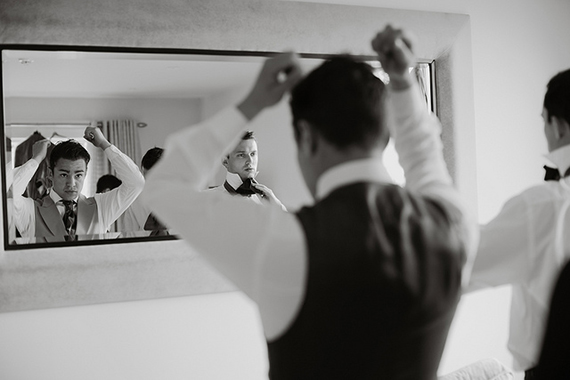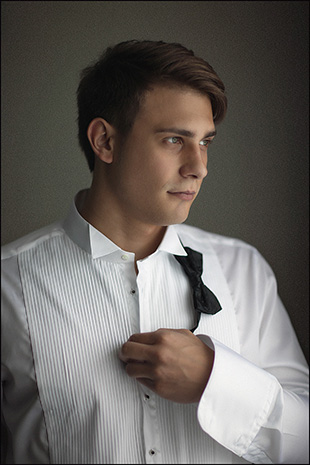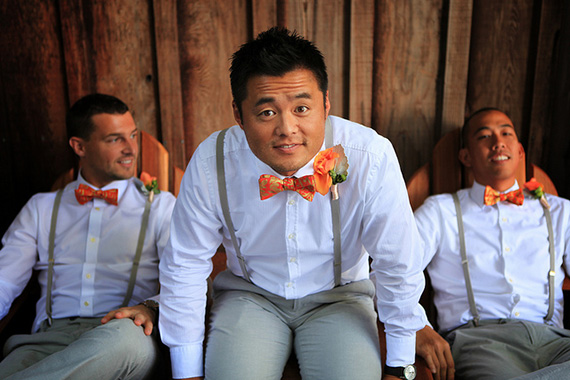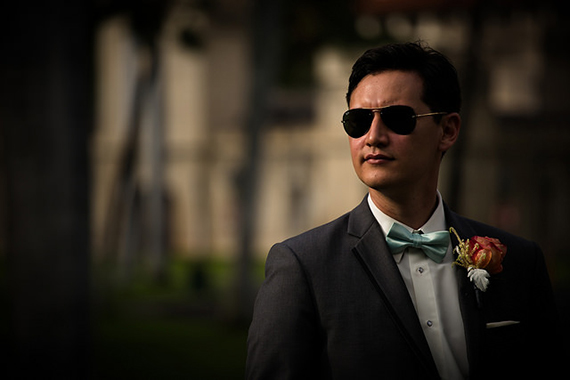We already covered bride photography tips. Now it’s time to discuss the groom.

photo by John Hope
Photographing the groom seems to fall into two categories for me. Either I don’t get to be with the groom until he arrives at the church/ceremony room, or I’m flitting between the bride and the groom because they’re in the same location getting ready. So I’ll treat these as two separate approaches, although the principle is the same: what’s the story and how can I capture it in the best way?
At the Hotel/House
I always arrange a time when I’m going to find the groom and his party so they know when to expect me. This is very important because I want to get the story of getting ready as it happens and not have to re-stage it (which I wouldn’t do anyway). I almost certainly have been with the bride first, so I arrange a time that allows the groom’s party plenty of time to change and get to the venue/church, thus allowing me to get back to the bride for the getting into the dress shots.
The approach to shooting the guys is basically the same as the bride: be relaxed, let the story unfold, know where the best light is, and gently move people to it if necessary. There are certain moments I’m looking for that I know will tell the story visually, and it depends on what has had to occur before I get there as to how many I can capture. I can’t be in two places at once. (I’ll talk about second shooters in a separate article).

photo by Sergey Podtsepko
Ideally, this is what I’d like to see:
- Shaving/post shower towelling (nothing naked, although some men have no inhibitions)
- Other groomsmen arriving
- Suits hanging up
- Shoe polishing
- Getting suited and booted
- Cufflinks and watches (think of these as the male equivalent of tiaras and earrings)
- Buttonholes (these may not arrive until the church)
- Rings being handed over or checked
- Any of the usual macho male bonding rituals—unlike with bride’s friends, the groomsmen see it as their job to undermine the confidence of the groom at very opportunity. (Please note that I am generalizing greatly, but as a man and a husband I might have the right.)
Generally men get changed very quickly, so you have to be on your toes. There is no taking your time and savoring the ritual that you find with the bride. Getting into the suit is the prerequisite for getting to the pub/church/venue as soon as possible so the day can begin. For me the same image rules apply but you might have to shoot fast. I’m looking for wide establishing shots to give us the context/setting, medium shots to show relationships and emotion, plus lots of detail shots to show us the rituals of the ‘uniform’ being donned (it might the best the groom ever looks and he will want images that reflect how smart/fashionable/individual and ‘hot’ he looks—it’s no different from the bride).
Once everyone is ready it’s nice, if time allows, to spend some time just melting into the background and capturing the interaction between the group of friends as they prepare to leave. They’re the smartest they’re going to be all day, filled with anticipation of what’s going to happen and certainly playing on the groom’s nervousness (despite what anyone claims, I’m sure that any groom is apprehensive about his role in the day). This time is an opportunity to get some interesting, fun, and sometimes touching images of the groom’s party interacting amongst themselves. The rest of the day they will be with other people and have duties to perform.

photo by Evan Blaser
At the Church
Often the first contact I have with the groom and his party on the day is at the church (or ceremony venue). Preparations have ben done at this point and I don’t tend to ask them to stage any of the getting ready list (often photographers will ask the groom to show his cufflinks or get the best man to hold up the rings, but it’s not really my style so I tend not to start the day by making them do this). Flowers will have been delivered to the bride’s house and the buttonholes then brought on to the church. I’ll often volunteer to take the buttonholes myself as I then know that when I arrive I’ll at least get shots of them being pinned to suits.
At the church I tend to step back initially and get reportage shots of the groomsmen performing their duties: handing out orders of service, showing people to seats, welcoming guests they know—it’s all the texture of the day. I’m moving constantly from inside to outside the church. Many different stories are playing out on both sides of the arched doorway. I’m aware that the groom and best man will be together getting instruction from the vicar/registrar. I’ll get a shot of the interaction but always from a distance; I don’t think it’s appropriate to get into people’s faces when important information is being imparted or risk distracting them.
One really important thing to do at this stage is to try to have a word with the minister/registrar to confirm what level of photography they are comfortable with during the service. I don’t just assume that I’ll be allowed to do my thing. More often than not there are restrictions. This may sound obvious but I want to appear polite and professional, so I always announce my name, shake hands, and tell them I’m the official photographer. Before they can trot out their usual rules I try to make clear the style of photography I employ: low-impact, natural light, no flash, not moving around and respectful of the most important part of the day (the marriage ceremony). This usually allays any fear they had that I might be intrusive or distracting and might mean that I get fewer restrictions than other photographers. However, some have been ‘burnt’ by photographers before and I have been faced with, “No photographs during the ceremony at all. One of the kiss and only from the back of the church on the way in and out.” And I don’t argue. I don’t want to make a fuss on someone else’s day, but I do tell the groom of the restrictions; I don’t want to be accused of not doing a proper job.
Moving from inside to outside a lot means you get to know your camera settings very well. I used to shoot every wedding on manual setting and was constantly having to commit settings to my short term memory as I flitted in and out and made adjustments on the fly. Now I know the look I want—subject isolated by narrow depth of field—so I’m on aperture priority for most of the time and can let the camera make shutter speed decisions. Just make sure that the shutter speed never drops too low (anything above 1/125 of a second is good for me). I always use Auto ISO settings, which I love, just making exposure compensation adjustments when shooting against the light; it really beats forgetting to change the ISO when moving outside and finding everything is blown out because I’m still on 1600 ISO.

photo by Johnny Silvercloud
If there’s time and the groom doesn’t look too stressed, there are a couple of shots I like to cross off my list before the service. I’ll aim to get a hero shot of the groom: a nice portrait in natural light. It creates a nice symmetry in an album as I have a similar single shot of the bride. Also, if I can gather all the groom’s party together (and I haven’t done it just after they were ready) I will shoot the portrait of the groom with his groomsmen. Two reasons to do it now: 1.) They look the best they are going to look all day, and 2.) I can cross it off my ‘formal’ list and don’t have to soak up time doing it later.
So by this stage of the day everyone is dressed, the groom’s at the church/ceremony room, guests are arriving (I don’t shoot everyone arriving but try to capture the build up by shooting a few happy, excited family members and friends), the bride is on her way, and the first big focal point of the day is about to happen…
About the Author:
I am a professional wedding photographer based in Staffordshire, England (you can find me on Flickr). My approach to wedding photography is to create a natural, relaxed set of images telling the story of the day. I am passionate about ‘good’ wedding photography and believe t it is the photographer’s job to create a very individual set of images of each wedding day. I live with Rachel, my wife, and shoot all over the UK.
Go to full article: Groom Preparations: Wedding Photography Tips
What are your thoughts on this article? Join the discussion on Facebook
PictureCorrect subscribers can also learn more today with our #1 bestseller: The Photography Tutorial eBook
The post Groom Preparations: Wedding Photography Tips appeared first on PictureCorrect.